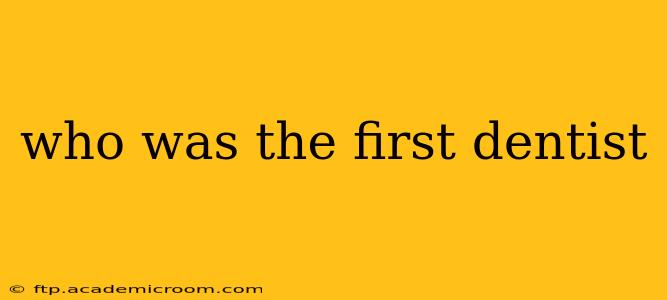Who Was the First Dentist? Unraveling the History of Dentistry
Pinpointing the very first dentist is a surprisingly complex task. While we can trace the practice of dentistry back thousands of years, identifying a single individual as the "first" is difficult due to a lack of comprehensive historical records. Instead, we find a fascinating evolution of techniques and understanding spanning various cultures and eras.
What evidence is there of early dentistry?
Evidence suggests rudimentary dental practices existed in ancient civilizations. Archaeological findings reveal instances of tooth extraction, fillings, and even early forms of orthodontics in ancient Egypt, Mesopotamia, and even pre-Columbian America. These weren't performed by individuals we'd recognize as dentists in the modern sense, but rather by healers, shamans, or even skilled artisans who incorporated dental procedures into their broader practice.
Were there specific individuals recognized for early dental work?
While we can't identify a single "first dentist," certain historical figures stand out for their contributions to the development of dental techniques and knowledge. In ancient Greece, Hippocrates (460-370 BC), often considered the "Father of Medicine," wrote about dental issues and treatments, indicating a growing awareness of the importance of oral health. Similarly, in ancient Rome, Aulus Cornelius Celsus (c. 25 BC – 50 AD), a prolific writer on medicine, provided detailed descriptions of dental procedures in his encyclopedia. These figures weren't dentists as we know them, but their writings represent significant steps in the documentation and understanding of dental problems and interventions.
When did dentistry emerge as a distinct profession?
The evolution of dentistry into a recognized profession took centuries. Significant advancements occurred during the 18th and 19th centuries with the development of specialized tools, improved techniques, and the establishment of dental schools. Figures like Pierre Fauchard (1678-1761), often called the "Father of Modern Dentistry," played a pivotal role. His comprehensive treatise, Le Chirurgien Dentiste, published in 1728, significantly advanced dental knowledge and practice, laying a foundation for the profession's future development.
What were some early dental tools and techniques?
Early dental tools were rudimentary compared to modern instruments. Tools ranged from simple chisels and files to crude forceps used for extractions. Fillings might have been made from materials like beeswax or gold. Techniques were often based on trial and error and lacked the scientific understanding we have today concerning oral hygiene and infection control.
How did the understanding of dental health evolve over time?
Understanding of oral health has evolved dramatically. Early practices focused primarily on treating existing problems like toothaches and decay. The link between oral health and overall well-being is a relatively recent understanding, driven by advancements in microbiology and our understanding of systemic diseases. Modern dentistry focuses not just on treating problems but also on prevention through practices like regular brushing, flossing, and professional cleanings.
In conclusion, while we cannot definitively name the "first dentist," the history of dentistry reveals a gradual evolution from rudimentary practices in ancient civilizations to the sophisticated profession we know today. The contributions of numerous individuals across centuries, from ancient healers to pioneers like Pierre Fauchard, have shaped the field into what it is now – a critical component of overall health and well-being.
